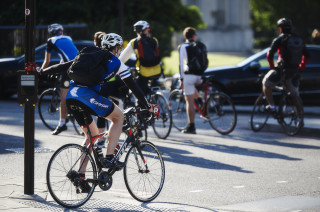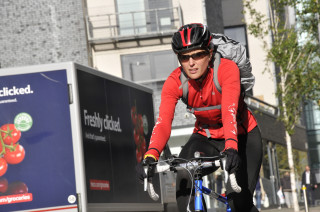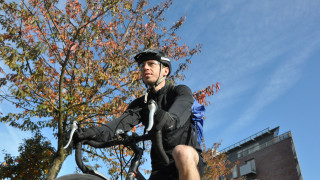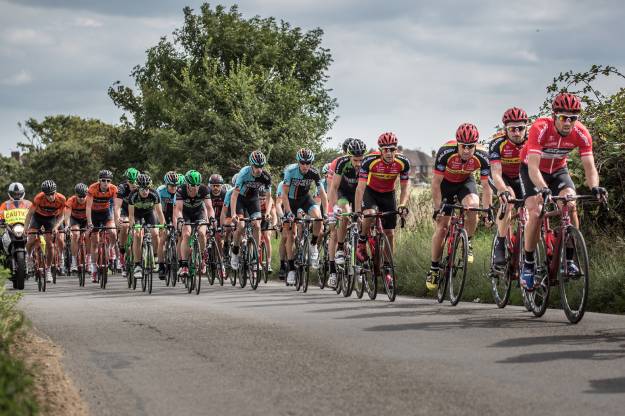At British Cycling we want our members to enjoy cycling safely. Here are ten useful tips to help you along the way. Also, check out our Ridesmart videos for more information on keeping safe and improving your riding.
1. Plan your journey before you set off
If you have a long ride ahead of you or if you are new to cycling and are likely to get tired before you reach your destination, alter your route to take this into account. This may mean using quiet roads or cycling facilities, such as off-road cycle paths, towards the end of your journey or stopping for a quick break. This might sound simple but accidents commonly happen towards the end of a ride. If you know your route well, you can plan the road ahead more effectively. Why not have a look at Let’s Ride Routes to plan your route?
2. Anticipate movements
Some vehicles travelling in front of you may need to stop quickly. You need to leave enough distance between you and the vehicle ahead so that you can pull up safely if it suddenly slows down or stops.
Braking distances vary on bikes so know yours before setting off on the road. Remember to take account of the road conditions and weather and be mindful that it takes longer to stop on a bike than it does in a car. What is happening around you can change very quickly so make sure you stay aware of your surroundings at all times.
3. Think about your road positioning
On quiet roads, in slower-moving traffic and at junctions or road narrowings you should ride in the centre of your lane to make yourself as clearly visible as possible.When riding on busy roads, allow vehicles to overtake where it is safe to do so whilst keeping at least 0.5 metres away, and further where it is safer, from the kerb edge.
When riding in a group cyclists can ride 2 abreast when safe to do so.

4. Monitor your speed and use your brakes effectively
It’s great to use declines to build up some speed without exerting any energy but to ensure you are in control and able to avoid any oncoming vehicles in your path, cycle at a safe and consistent speed.
5. Be aware and anticipate
Always be aware of what is happening around you. This includes vehicles on the opposite side of the road which can cut across your path, vehicles waiting to pull out of minor roads into the major road and vehicles moving out into your lane to avoid parked cars or swerving to avoid hazards. When passing side roads assess the intentions of other road users, for example, are they indicating?
Remember the hierarchy of road users, those most at risk are at the top of the hierarchy, cyclists have a responsibility to reduce danger to pedestrians. At junctions, pedestrians have priority if crossing or waiting to cross.
6. Be seen
The Highway Code advises that you should wear light-coloured or fluorescent clothing in daylight and poor light conditions it also recommends reflective clothing and/or accessories in the dark.
Move into the primary position to pass side roads in order to maximise the chances of you being seen.
Make sure you know the Highway Code regarding lights and reflectors – it is a legal requirement for you to have a white front and red rear light lit at night and to have a red rear reflector attached (in addition, amber pedal reflectors must be fitted if the bike was manufactured after 01/10/1985).

7. Communicate with other road users
Try to make eye contact with drivers/pedestrians to check whether they have seen you. If the other road user is not looking at you, they may not have seen you!
8. Avoid filtering when it will put you in conflict with other road users
Filtering is a useful way for cyclists to get ahead of queuing traffic. However, you should be aware when filtering past junctions as vehicles travelling in the same direction as you may give way to oncoming right turning traffic, which may well be out of your line of sight and may not be aware of your presence. Be extremely careful if passing an HGV, LGV or other long vehicle (for example, a coach or bus) on the inside. Avoid this if at all possible.
9. Check for a gap in the traffic when avoiding obstructions
If you can only avoid an obstruction by moving out into the flow of traffic, check over your right shoulder first to ensure you have room to move out. If a vehicle is travelling too close to you to allow this, slow down until you have a safe gap
10. Cross tramlines and level crossings safely
If you need to cross tramlines do so slowly and as close to a 90 degree angle as possible to avoid your tyres slipping into the gap and becoming trapped. The Highway Code advises cyclists to dismount where a ‘Cyclist Dismount’ sign is displayed.
Finally, always remember to follow the Highway Code.








